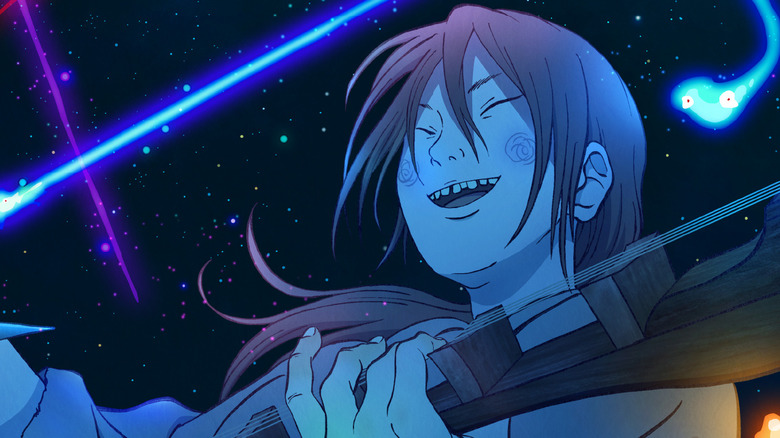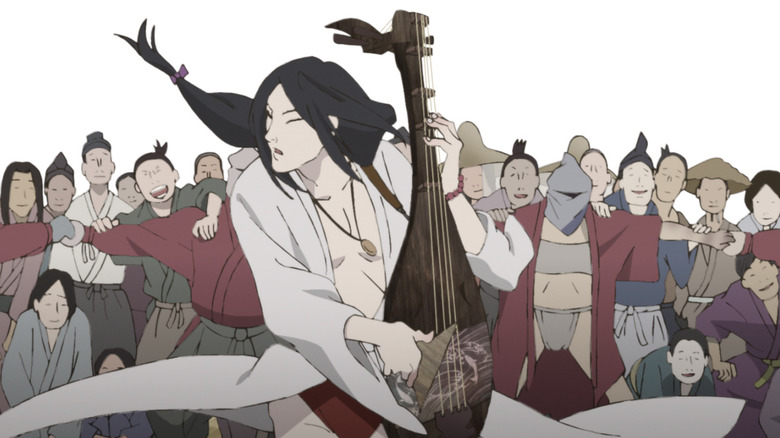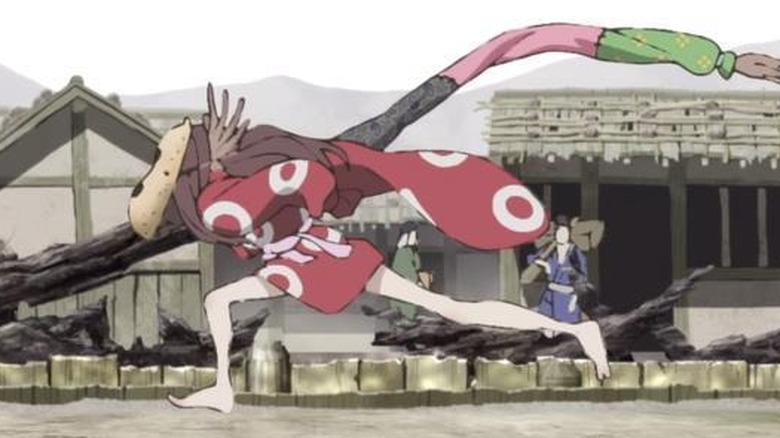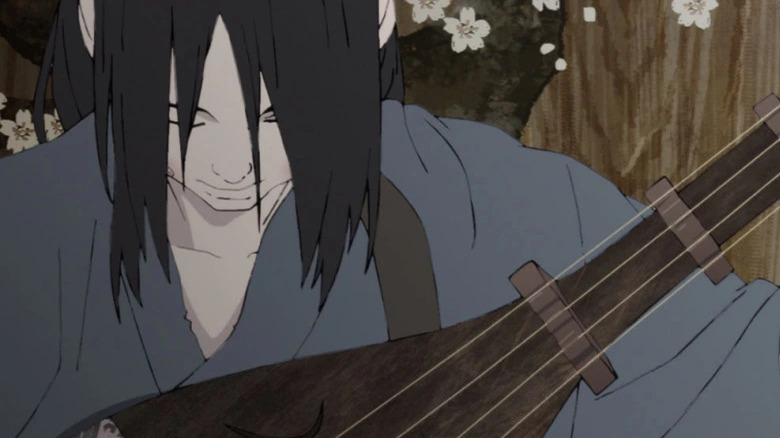Inu-Oh Review: Glam-Rock In Feudal Japan
Music is transportive to the extremes in Masaaki Yuasa's works. In his 2008 anime "Kaiba," there's a heartbreaking organ scene that inspires a bitter old woman to reminisce on long-lost affection. In "Ride Your Wave," a cheesy love song summons the spirit of a deceased loved one, fleetingly, like an incantation. Yuasa and Science SARU's latest feature cocktail "Inu-Oh," steeped in the 14th century Muromachi period of the ruling shoguns, rolls out rock music that unleashes the restorative power to unlock revelations to mysteries, gives restless ghosts peace through lyrical storytelling, and allow two misfits to assert their place in the world.
Based on Hideo Furukawa's novel "The Tale of the Heike: The INU-OH Chapters," Akiko Nogi's adapted screenplay kickstarts the film deceptively. At the behest of shady noblemen, young Tomona (Mirai Moriyama) opens an underwater cursed treasure that blinds him and kills his father (Yutaka Matsushige). The first 20 minutes misdirects you into believing that you're watching a revenge tale that may end in tragedy — complete with the father's ghost haranguing his son's conscience to avenge his death with the sternness of Hamlet's slain father. There ends up being a more unexpected tragedy at the end of the tunnel.
Unfolding like a folktale
The film's surprising turns — even if they may feel rude at first — are an asset since the film operates on the ethos that destiny is more fluid than anticipated. Disregarding his ghostly father's revenge orders, the boy finds a greater purpose than a revenge quest: joining a league of blind biwa players who lyrically preserve the stories of the fallen Heike clan. At the capital, his path crosses with the eponymous gourd-masked entity (known as the "Dog King"), a sprightly lump of limbed flesh clothed in patchwork and a grotesque face concealed behind a gourd mask. A town pariah, Inu-Oh (Avu-chan) scrounges around for dog scraps, mischief, and the Noh sounds of percussion and flutes pouring from the theatre house that inspires him to dance.
Amused that his cursed form can't terrorize the blind Tomona, Inu-Oh becomes enchanted with Tomona's music, a style so unorthodox from traditional biwa playing. From there, they bloom a partnership and discover their musical muses in the restless spirits of the fallen Heike samurai, leading them to compose an album of new Heike stories outside of the canon. Armed with the ambition, breathtaking stagecraft, Tomona's rock-star stage attitude, Inu-Oh's anachronistic breakdancing and ballet, their rock performances sway cheering scores of fans. But, in the name of political motives, the old order of shoguns rears its authoritative head to sabotage and snuff out their artistic ripples into society.
Otomo Yoshihide's stellar rock music
It becomes futile to resist the intoxication of Otomo Yoshihide's rock music and the visual excess. Yoshihiro Sekiya's cinematography dances with Inu-Oh's supernatural ballad, extending and sprawling across the lakes and stage. Easily, those concerts are the most enthralling and splashiest sequences, recreating the adrenaline of witnessing stagecraft, all culminating into a hell-raising musical finale. Admittedly, during those electrifying concerts, the main pair do morph into animators' dancing puppets as a means to showcase spectacular animation, sprinkled with intermittent reminders that they're supposed to be characters.
Still, the brunt of the pairs' musical coming-of-age is pronounced in their physical evolution (character creation by Taiyo Matsumoto, and character design by Nobutake Ito). Shredding on the biwa, Tomona becomes Tomoari (the fluidity of his name plays a profound role), flaunts an extending hair (to the chagrin of head-shaven biwa priests), and embraces an androgynous appearance.
Mirai Moriyama's rumbly voice makes him a fire-forged partner to Avu-chan's airiness. Getting choreographic mileage out of an elongated arm three times his height and showing off silky footwork, Inu-Oh is one of the most richly expressive players of the Yuasa-verse. And matching the dexterous physicality is Inu-Oh's scintillating voicework by the Queen Bee lead singer, who especially weaponizes a sprawling range that soars to a bracing falsetto. The more Inu-Oh regales his audience, the more he transforms feature-by-feature from a mass with misshapen limbs into a dancing human body. The power of music de-curses him into a new form that doesn't necessarily hinder his expressiveness, but there's thought given to the implication of him gaining a more socially acceptable beauty that gets co-opted later for the designs of the higher-ups.
Masaaki Yuasa's vision
Science SARU has spilled out a number of striking animation, such as Naoko Yamada's "The Heike Story" series (one of Science SARU's poetically restrained efforts and a recommended companion watch since its Japanese-specific narrative is relevant to the historical backdrop of "Inu-Oh"). A director notorious for mutable impulses rather than organized details, Masaaki Yuasa's free-forming versatility is not to be trifled with, love or hate his flair. His handiwork ensures a kaleidoscopic experience, a fever dream that paints active imagination in environmental interactions (a blind child "sees" music in the blotted colors of the biwa strings or the jaws of its singer) or the momentum of music (in a stomp-stomp performance that echoes Queen's "We Will Rock You," the projection of a golden whale surfaces).
A western viewer (me) may come in ignorant about the knowledge that Inu-Oh was a real-life 14th-century Noh performer, with few historical records surviving to this day. With that in mind, "Inu-Oh" can be read as a memorial to the forgotten by coloring in the historical chasm with contemporary imagination. I also said before that there is a tragedy at the end of the tunnel. But it's also topped with a coda that says something, once again, about the restorative power of music.



